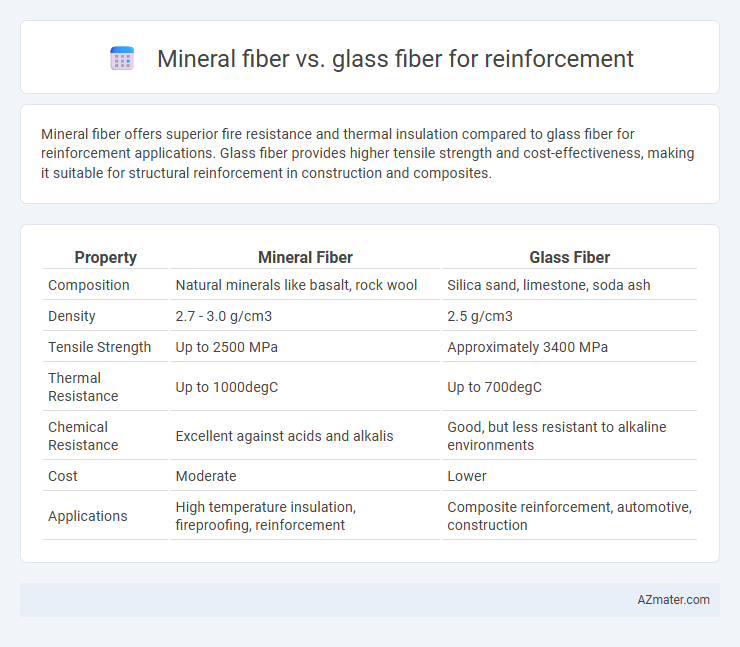Mineral fiber offers superior fire resistance and thermal insulation compared to glass fiber for reinforcement applications. Glass fiber provides higher tensile strength and cost-effectiveness, making it suitable for structural reinforcement in construction and composites.
Table of Comparison
| Property | Mineral Fiber | Glass Fiber |
|---|---|---|
| Composition | Natural minerals like basalt, rock wool | Silica sand, limestone, soda ash |
| Density | 2.7 - 3.0 g/cm3 | 2.5 g/cm3 |
| Tensile Strength | Up to 2500 MPa | Approximately 3400 MPa |
| Thermal Resistance | Up to 1000degC | Up to 700degC |
| Chemical Resistance | Excellent against acids and alkalis | Good, but less resistant to alkaline environments |
| Cost | Moderate | Lower |
| Applications | High temperature insulation, fireproofing, reinforcement | Composite reinforcement, automotive, construction |
Introduction to Fiber Reinforcement
Fiber reinforcement enhances composite materials by improving strength, durability, and impact resistance. Mineral fiber, derived from natural or synthetic minerals, offers excellent thermal stability and fire resistance, making it suitable for high-temperature applications. Glass fiber, typically made from silica-based materials, provides superior tensile strength and cost-effectiveness, widely used in construction and automotive industries.
What is Mineral Fiber?
Mineral fiber is a type of reinforcement material composed primarily of basalt or other natural minerals, offering high thermal resistance and superior durability compared to traditional glass fiber. It provides enhanced mechanical properties and insulation capabilities, making it ideal for construction and industrial applications where strength and fire resistance are critical. Mineral fiber also exhibits better chemical stability and lower water absorption, ensuring long-term performance in harsh environments.
What is Glass Fiber?
Glass fiber, a material made from extremely fine fibers of glass, is widely used as reinforcement due to its high tensile strength, durability, and resistance to heat and chemicals. Compared to mineral fiber, glass fiber offers superior mechanical properties and enhanced bonding with resin matrices, making it ideal for composite materials in automotive, aerospace, and construction industries. Its lightweight nature and corrosion resistance contribute to improved structural performance and longevity of reinforced products.
Key Physical Properties Comparison
Mineral fiber exhibits superior thermal resistance and higher melting points compared to glass fiber, making it ideal for high-temperature applications. Glass fiber offers greater tensile strength and flexibility, which enhances impact resistance and structural reinforcement in composites. Both fibers differ significantly in density and moisture absorption, with mineral fiber often being denser and less prone to water retention.
Strength and Durability Analysis
Mineral fiber exhibits higher tensile strength and superior thermal resistance compared to glass fiber, making it more suitable for high-stress reinforcement applications in extreme environments. Glass fiber offers excellent tensile strength but is more prone to degradation under prolonged exposure to moisture and UV radiation, impacting its long-term durability. Durability analysis reveals that mineral fibers maintain structural integrity over extended periods, while glass fibers require protective coatings to enhance lifespan in harsh conditions.
Thermal and Chemical Resistance
Mineral fiber offers superior thermal resistance, withstanding temperatures above 1,000degC, making it ideal for high-temperature insulation applications compared to glass fiber, which typically resists up to 540degC. Chemically, mineral fibers demonstrate excellent stability in acidic and alkaline environments, resisting corrosion better than glass fibers that can degrade when exposed to strong chemicals. This makes mineral fiber reinforcement preferred for industrial settings requiring durable thermal and chemical resilience.
Applications in Construction and Industry
Mineral fiber offers superior fire resistance and thermal insulation, making it ideal for high-temperature applications in construction such as fireproof cladding and acoustic panels. Glass fiber provides enhanced tensile strength and flexibility, widely used in reinforced concrete, roofing materials, and industrial composites. Both materials improve structural durability but are selected based on specific performance requirements like temperature tolerance and mechanical stress.
Environmental Impact and Sustainability
Mineral fiber and glass fiber both serve as reinforcements in construction, but mineral fiber typically offers enhanced environmental benefits due to its higher recyclability and lower embodied energy in production. Glass fiber, although widely used for its strength and cost-effectiveness, has a larger environmental footprint because of energy-intensive manufacturing processes and challenges in recycling. Sustainable construction increasingly favors mineral fiber for reducing carbon emissions and enhancing lifecycle eco-efficiency in composite materials.
Cost Considerations
Mineral fiber generally incurs higher initial costs compared to glass fiber due to its specialized manufacturing processes and superior thermal resistance properties. Glass fiber offers a more cost-effective solution for reinforcement applications, benefiting from widespread availability and lower production expenses. Choosing between mineral fiber and glass fiber depends on balancing budget constraints with performance requirements, where glass fiber typically provides the best value for general reinforcement needs.
Choosing the Right Fiber for Your Project
Mineral fiber offers superior fire resistance and thermal insulation, making it ideal for projects requiring enhanced safety and temperature control, while glass fiber excels in tensile strength and is widely used for its cost-effectiveness and durability. Choosing the right reinforcement fiber depends on project-specific factors such as environmental exposure, mechanical demands, and budget constraints. Evaluating these criteria ensures optimal performance and longevity of the reinforced material.

Infographic: Mineral fiber vs Glass fiber for Reinforcement
 azmater.com
azmater.com